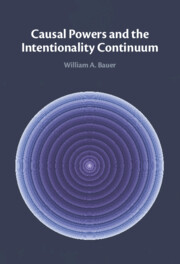Book contents
- Causal Powers and the Intentionality Continuum
- Causal Powers and the Intentionality Continuum
- Copyright page
- Dedication
- Contents
- Figures
- Preface
- Acknowledgments
- Abbreviations
- Introduction
- Part I Why Powers?
- Part II What Are Powers Like?
- Chapter 3 Powers from the Inside
- Chapter 4 A Defense of Physical Intentionality
- Chapter 5 A Defense of Physical Intentionality
- Chapter 6 Powers from the Inside
- Chapter 7 Powers from the Outside
- Chapter 8 Nature’s Intentionality Continuum
- Works Cited
- Index
Chapter 4 - A Defense of Physical Intentionality
Essential Marks
from Part II - What Are Powers Like?
Published online by Cambridge University Press: 13 October 2022
- Causal Powers and the Intentionality Continuum
- Causal Powers and the Intentionality Continuum
- Copyright page
- Dedication
- Contents
- Figures
- Preface
- Acknowledgments
- Abbreviations
- Introduction
- Part I Why Powers?
- Part II What Are Powers Like?
- Chapter 3 Powers from the Inside
- Chapter 4 A Defense of Physical Intentionality
- Chapter 5 A Defense of Physical Intentionality
- Chapter 6 Powers from the Inside
- Chapter 7 Powers from the Outside
- Chapter 8 Nature’s Intentionality Continuum
- Works Cited
- Index
Summary
This and the next chapter defend the Argument from the Marks of Intentionality: Since powers share relevant marks of intentionality with mental states, powers are intentional properties. After identifying ten marks of intentionality, including those advanced by C. B. Martin and Karl Pfefier at the beginning of the physical intentionality debate, this chapter focuses on applying what are arguably the three essential marks of intentionality: directedness, intentional inexistence, and intentional indeterminacy. Directedness, inherently connected to intentional inexistence, is the main focus here: Just as thoughts are directed toward objects that need not exist, powers are directed toward manifestations that need not occur. The discussion explores what directedness is and is not. It is argued that directedness is a representational phenomenon. Therefore, since powers are directed, they are representational intentional states, contrary to George Molnar’s claim that powers are nonrepresentational intentional states. The concluding section argues that powers, like thoughts, display indeterminacy.
Keywords
- Type
- Chapter
- Information
- Causal Powers and the Intentionality Continuum , pp. 91 - 112Publisher: Cambridge University PressPrint publication year: 2022



